Link between the Reactivity of Slag and the Strength Development of Calcium Aluminate Cement
Abstract
:1. Introduction
2. Materials and Methods
2.1. Materials
2.2. Methods
3. Results
3.1. Chemical Reactivity of GGBS
3.2. Effect of Slags on CAC Paste and Mortar Properties
3.3. Correlation between Reactivity and Compressive Strength
3.4. Effect of Slag Reactivity on CAC Phase Assemblage
3.5. Effect of Slag on CAC Conversion Process
4. Discussion
5. Conclusions
Author Contributions
Funding
Institutional Review Board Statement
Informed Consent Statement
Data Availability Statement
Conflicts of Interest
Appendix A
| Reactivity Index | Definition | Criteria | S1 | S2 | S3 | S4 | S5 |
|---|---|---|---|---|---|---|---|
| Basicity according to Tetmajer | - | 0.91 | 1.20 | 0.87 | 1.14 | 1.09 | |
| German Standard for “Eisenportlandzement” | ≥1 | 0.90 | 1.04 | 0.81 | 1.04 | 0.97 | |
| German Standard for “Hochofenzement” I | ≥1 | 1.06 | 1.22 | 0.96 | 1.20 | 1.16 | |
| German Standard for “Hochofenzement” II | MnO | ≤5 wt% | 1.80 | 0.20 | 1.60 | 0.40 | 0.30 |
| German Standard for special cements | ≥1 | 1.50 | 1.71 | 1.35 | 1.64 | 1.71 | |
| F-value according to Keil | >1.5 | 1.31 | 1.63 | 1.22 | 1.54 | 1.58 | |
| Reactivity according to De Langavant | - | 33.85 | 42.00 | 30.45 | 39.75 | 41.05 | |
| Basicity according to Schwiete | - | 0.77 | 0.97 | 0.73 | 0.92 | 0.93 | |
| Reactivity according to Wang | - | 1.48 | 1.68 | 1.31 | 1.62 | 1.66 | |
| European Standards for cement and blast-furnace slag I | >1 | 1.18 | 1.38 | 1.05 | 1.34 | 1.33 | |
| European Standards for cement and blast-furnace slag II | >67 wt% | 83.10 | 84.30 | 81.70 | 85.80 | 83.10 | |
| F-value according to Ehrenberg | - | 1.29 | 1.60 | 1.16 | 1.52 | 1.52 |
References
- Lothenbach, B.; Scrivener, K.; Hooton, R.D. Supplementary cementitious materials. Cem. Concr. Res. 2011, 41, 1244–1256. [Google Scholar] [CrossRef]
- Siddique, R.; Khan, M.I. Supplementary Cementing Materials; Springer: Berlin/Heidelberg, Germany, 2011; p. 122. [Google Scholar] [CrossRef]
- Juenger, M.C.G.; Siddique, R. Recent advances in understanding the role of supplementary cementitious materials in concrete. Cem. Concr. Res. 2015, 78, 71–80. [Google Scholar] [CrossRef]
- Yang, K.H.; Jung, Y.B.; Cho, M.S.; Tae, S.H. Effect of supplementary cementitious materials on reduction of CO2 emissions from concrete. J. Clean. Prod. 2015, 103, 774–783. [Google Scholar] [CrossRef]
- Milovanović, B.; Štirmer, N.; Carević, I.; Baričević, A. Wood biomass ash as a raw material in concrete industry. Građevinar 2019, 71, 504–514. [Google Scholar] [CrossRef]
- Blotevogel, S.; Steger, L.; Hart, D.; Doussang, L.; Kaknics, J.; Poirier, M.; Bornhöft, H.; Deubener, J.; Patapy, C.; Cyr, M. Effect of TiO2 and 11 minor elements on the reactivity of ground-granulated blast-furnace slag in blended cements. J. Am. Ceram. Soc. 2020, 104, 128–139. [Google Scholar] [CrossRef]
- Pal, S.C.; Mukherjee, A.; Pathak, S.R. Investigation of hydraulic activity of ground granulated blast furnace slag in concrete. Cem. Concr. Res. 2003, 33, 1481–1486. [Google Scholar] [CrossRef]
- ASTM C1897-20; Standard Test Methods for Measuring the Reactivity of Supplementary Cementitious Materials by Isothermal Calorimetry and Bound Water Measurements. ASTM International: Philadelphia, PA, USA, 2020.
- De Belie, N.; Soutsos, M.; Gruyaert, E. Properties of Fresh and Hardened Concrete Containing Supplementary Cementitious Materials: State of the Art Report of the RILEM Technical Committee 238-SCM; Working Group 4; Springer: Cham, Switzerland, 2018. [Google Scholar] [CrossRef]
- Hallet, V.; De Belie, N.; Pontikes, Y. The impact of slag fineness on the reactivity of blended cements with high-volume non-ferrous metallurgy slag. Constr. Build. Mater. 2020, 257, 119400. [Google Scholar] [CrossRef]
- Bougara, A.; Lynsdale, C.; Milestone, N.B. Reactivity and performance of blastfurnace slags of differing origin. Cem. Concr. Compos. 2010, 32, 319–324. [Google Scholar] [CrossRef]
- Tironi, A.; Trezza, M.A.; Scian, A.N.; Irassar, E.F. Assessment of pozzolanic activity of different calcined clays. Cem. Concr. Compos. 2013, 37, 319–327. [Google Scholar] [CrossRef]
- Donatello, S.; Tyrer, M.; Cheeseman, C.R. Comparison of the test methods to assess pozzolanic activity. Cem. Concr. Compos. 2010, 32, 121–127. [Google Scholar] [CrossRef]
- Avet, F.; Snellings, R.; Diaz, A.A.; Haha, M.B.; Scrivener, K. Development of a new rapid, relevant and reliable (R3) test method to evaluate the pozzolanic reactivity of calcined kaolinitic clays. Cem. Concr. Res. 2016, 85, 1–11. [Google Scholar] [CrossRef]
- Blotevogel, S.; Ehrenberg, A.; Steger, L.; Doussang, L.; Kaknics, J.; Patapy, C.; Cyr, M. Ability of the R3 test to evaluate differences in early age reactivity of 16 industrial ground granulated blast furnace slags (GGBS). Cem. Concr. Res. 2020, 130, 105998. [Google Scholar] [CrossRef]
- Linderoth, O.; Wadsö, L.; Jansen, D. Long-term cement hydration studies with istohermal calorimetry. Cem. Concr. Res. 2021, 141, 106344. [Google Scholar] [CrossRef]
- Yang, H.M.; Zhang, S.M.; Wang, L.; Chen, P.; Shao, D.K.; Tang, S.W.; Li, J.Z. High-ferrite Portland cement with slag: Hydration, microstructure, and resistance to sulfate attack at elevated temperature. Cem. Concr. Com. 2022, 130, 104560. [Google Scholar] [CrossRef]
- Yang, H.J.; Ann, K.Y.; Jung, M.S. Development of Strength for Calcium Aluminate Cement Mortars blended with GGBS. Adv. Mater. Sci. Eng. 2019, 2019, 9896012. [Google Scholar] [CrossRef]
- Adams, M.P.; Lute, R.D.; Moffat, E.G.; Ideker, J.H. Evaluation of a Procedure for Determining the Converted Strength of calcium aluminate cement concrete. J. Est. Val. 2018, 46, 1659–1672. [Google Scholar] [CrossRef]
- Bizzozero, J. Hydration and Dimensional Stability of Calcium Aluminate Cement Based Systems. Ph.D. Thesis, École Polytechnique Fédérale de Lausanne, Lausanne, Switzerland, 2014. [Google Scholar]
- Hewlett, P.C.; Liska, M.; Fryda, H.; Touzo, B. Lea’s Chemistry of Cement and Concrete, 5th ed.; Calcium Aluminate Cements; Elsevier Ltd.: Amsterdam, The Netherlands, 2017; pp. 537–584. [Google Scholar]
- Kirca, Ö.; Yaman, I.Ö.; Tokyay, M. Compressive strength development of calcium aluminate cement-GGBFS blends. Cem. Concr. Compos. 2013, 35, 163–170. [Google Scholar] [CrossRef]
- Fu, T.; Adams, M.P.; Ideker, J.H. A Preliminary Study on A Calcium Aluminate Cement Concrete Maturity Theory in Predicting Conversion. In Proceedings of the 14th International Congress on the Chemistry of Cement, Beijing, China, 13–16 October 2015; Volume 10. [Google Scholar] [CrossRef]
- Quillin, K.; Osborne, G.; Majumdar, A.; Singh, B. Effects of w/c ratio and curing conditions on strength development in BRECEM concretes. Cem. Concr. Res. 2001, 31, 627–632. [Google Scholar] [CrossRef]
- Ionescu, D.V. The Hydraulic Potential of High Iron Bearing Steel Slags. Ph.D. Thesis, The University of British Columbia Vancouver, Vancouver, BC, Canada, 1999. [Google Scholar]
- Önder, K. Temperature Effect on Calcium Aluminate Cement Based Composite Binders. Ph.D. Thesis, The Graduate School of Natural and Applied Sciences of Middle East Technical University, Ankara, Turkey, 2006. [Google Scholar]
- Majumdar, A.J.; Singh, B.; Edmonds, R.N. Hydration of mixtures of ‘Ciment Fondu’ aluminous cement and granulated blast furnace slag. Cem. Concr. Res. 1990, 20, 197–208. [Google Scholar] [CrossRef]
- Ideker, J.H. Early-Age Behavior of Calcium Aluminate Cement Systems. Ph.D. Thesis, The University of Texas at Austin, Austin, TX, USA, 2008. [Google Scholar]
- ASTM C-188:2017; Standard Test Method for Density of Hydraulic Cement. ASTM International: Philadelphia, PA, USA, 2017.
- EN 15167-2:2024; Ground Granulated Blast Furnace Slag for Use in Concrete, Mortar and Grout—Part 2: Assessment and Verification of Constancy of Performance. European Standard: Brussels, Belgium, 2024.
- ASTM C1702-17; Standard Test Method for Measurement of Heat of Hydration of Hydraulic Cementitious Materials Using Isothermal Conduction Calorimetry. ASTM International: Philadelphia, PA, USA, 2017.
- EN 196-1:2016; Methods of Testing Cement—Part 1: Determination of Strength. European Standard: Brussels, Belgium, 2016.
- EN 14647:2005; Calcium Aluminate Cement—Composition, Specifications and Conformity Criteria. European Standard: Brussels, Belgium, 2005.
- EN 480-2:2007; Admixtures for Concrete, Mortar and Grout—Test Methods—Part 2: Determination of Setting Time. European Standard: Brussels, Belgium, 2007.
- EN 1015-3:1999/A2:2006; Methods of Test for Mortar for Masonry—Part 3: Determination of Consistence of Fresh Mortar (by Flow Table). European Standard: Brussels, Belgium, 2006.
- Kottegoda, N.T.; Rosso, R. Applied Statistics for Civil and Environmental Engineers; Blackwell Publishing: Hoboken, NJ, USA, 2008. [Google Scholar]
- Carević, I.; Baričević, A.; Štirmer, N.; Bajto, J.Š. Correlation between physical and chemical properties of wood biomass ash and cement composites performances. Constr. Build. Mater. 2020, 256, 119450. [Google Scholar] [CrossRef]
- Scheinherrová, L.; Trník, A. Hydration of calcium aluminate cement determined by thermal analysis. AIP Conf. Proc. 2017, 1866, 040034. [Google Scholar] [CrossRef]
- Liao, Y.; Wang, S.; Wang, K.; Qunaynah, S.; Wan, S.; Yuan, Z.; Xu, P.; Tang, S. A study on the hydration of calcium aluminate cement pastes containing silica fume using non-contact electrical resistivity measurement. J. Matr. Res. 2023, 24, 8135–8149. [Google Scholar] [CrossRef]
- Goergens, J.; Goetz-Neunhoeffer, F. Temperature-dependent late hydration of calcium aluminate cement in a mix with calcite—Potential of G-factor quantification combined with GEMS-predicted phase content. Cement 2021, 5, 100011. [Google Scholar] [CrossRef]
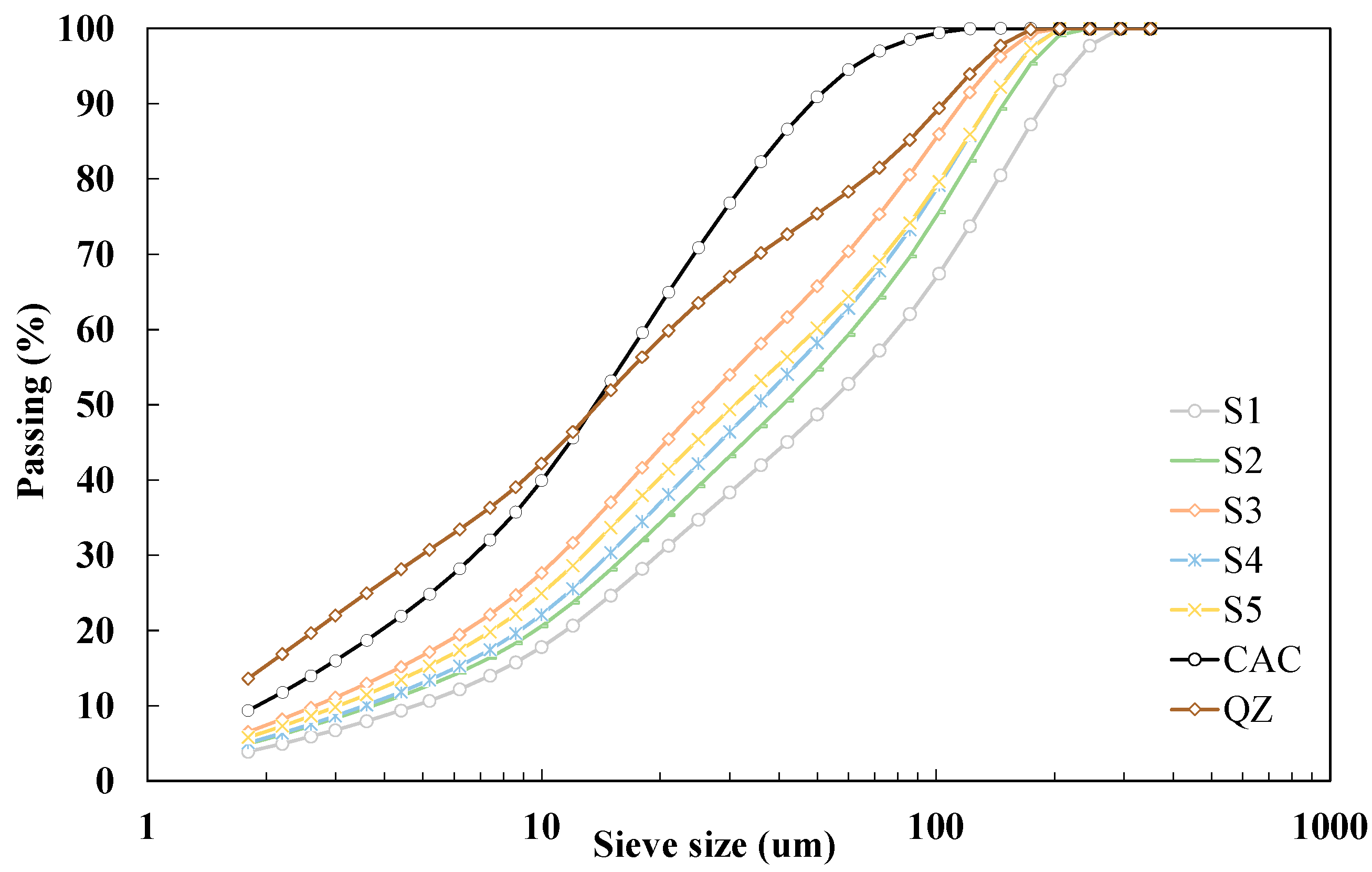
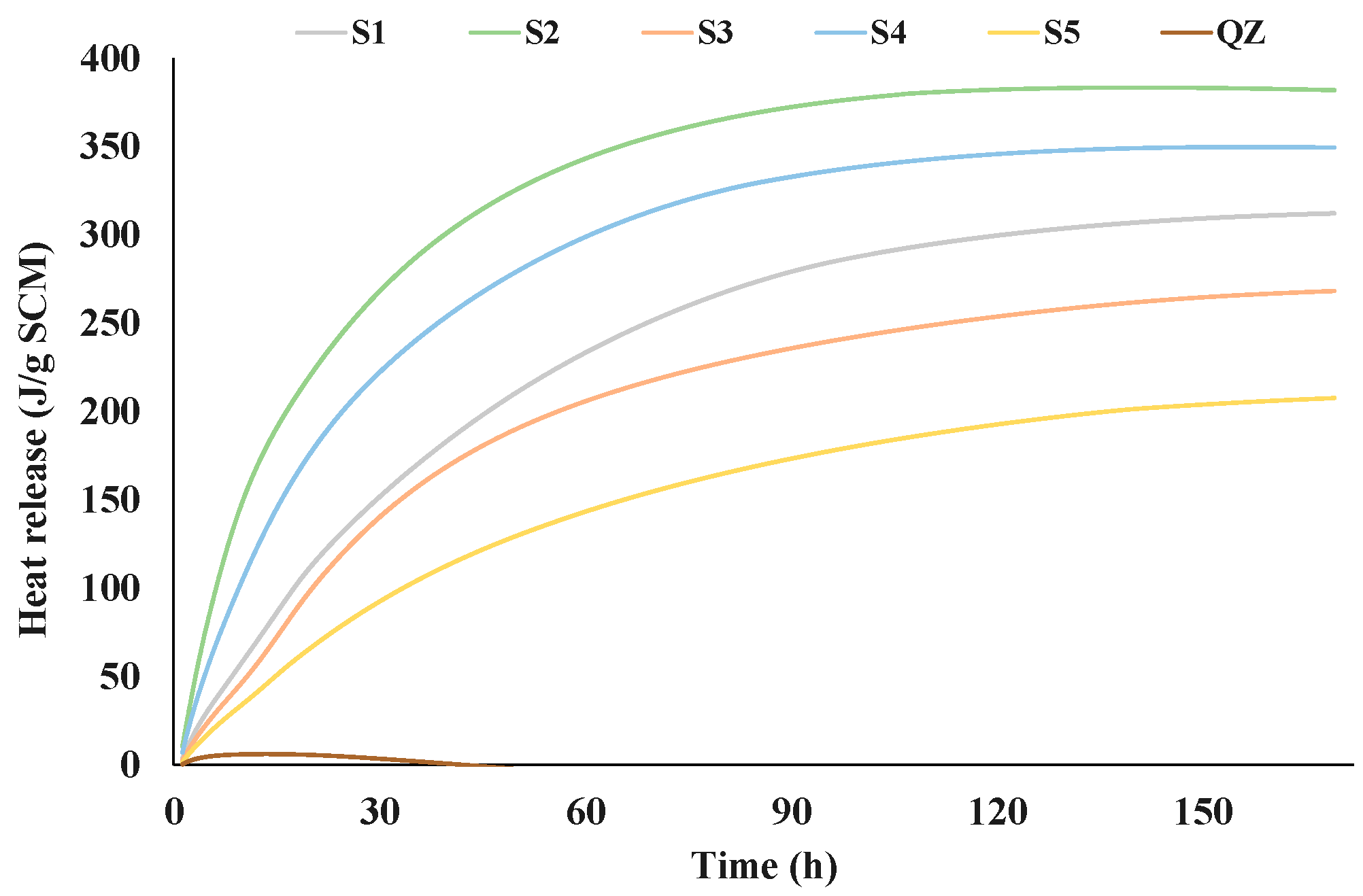
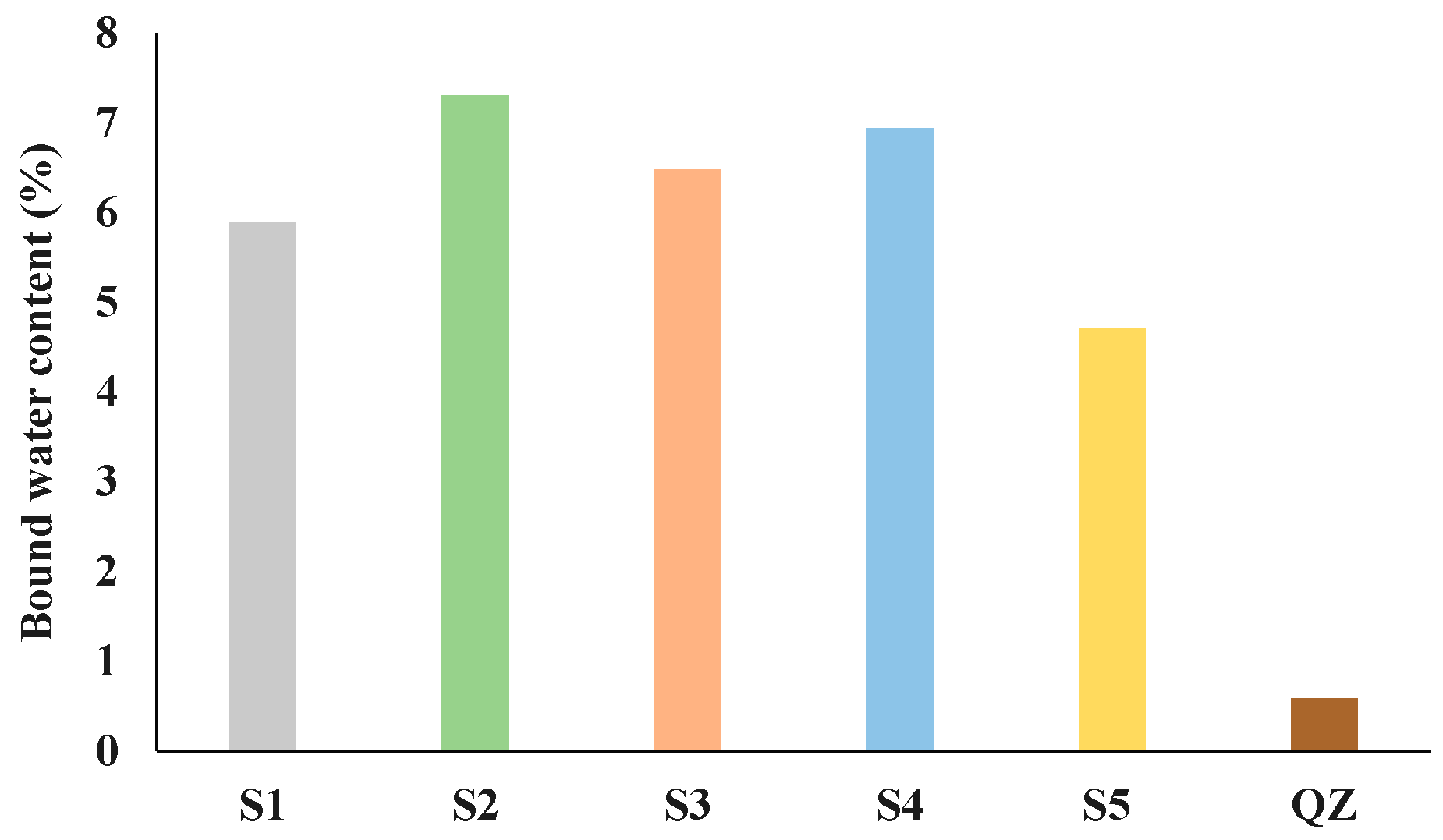
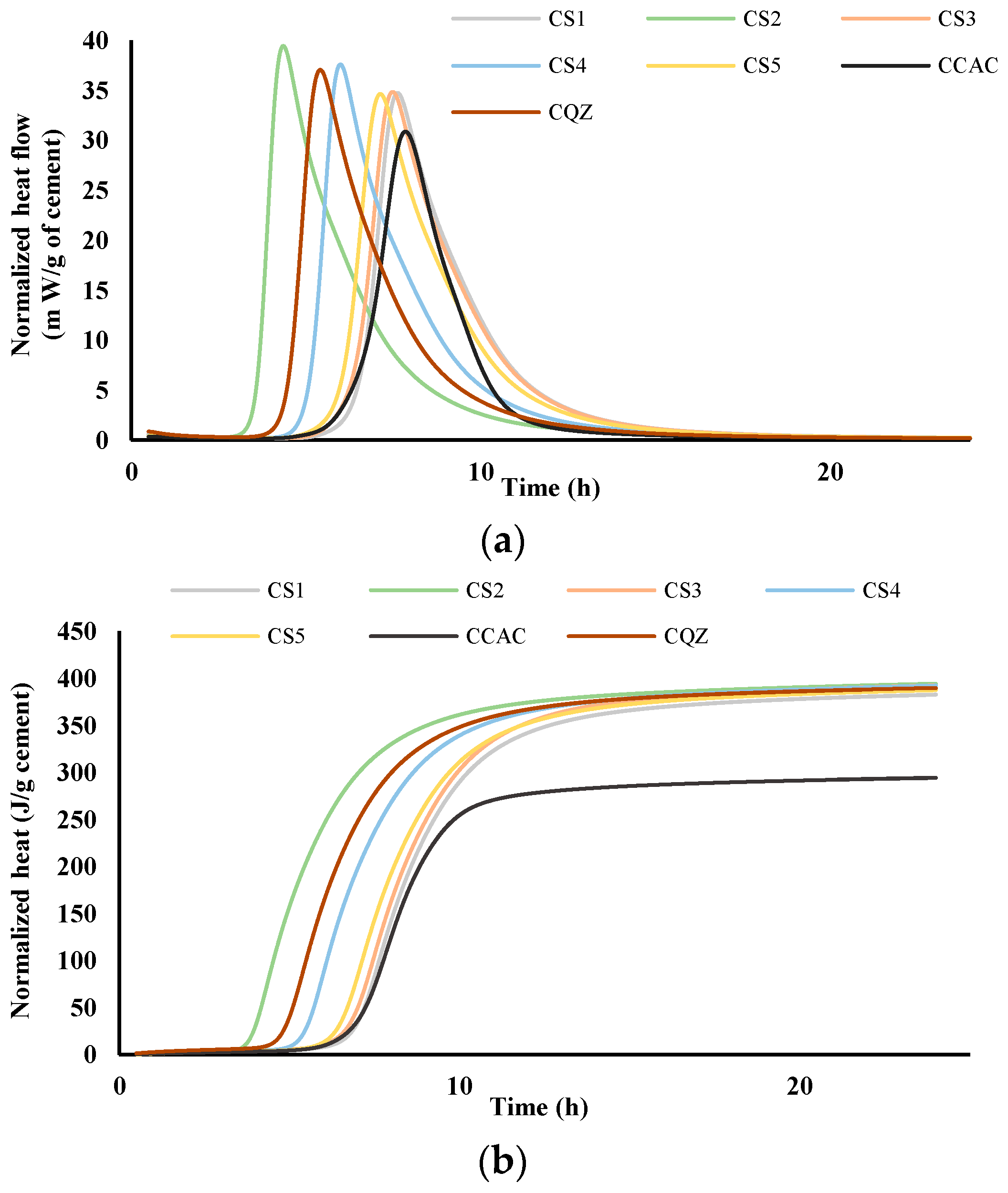

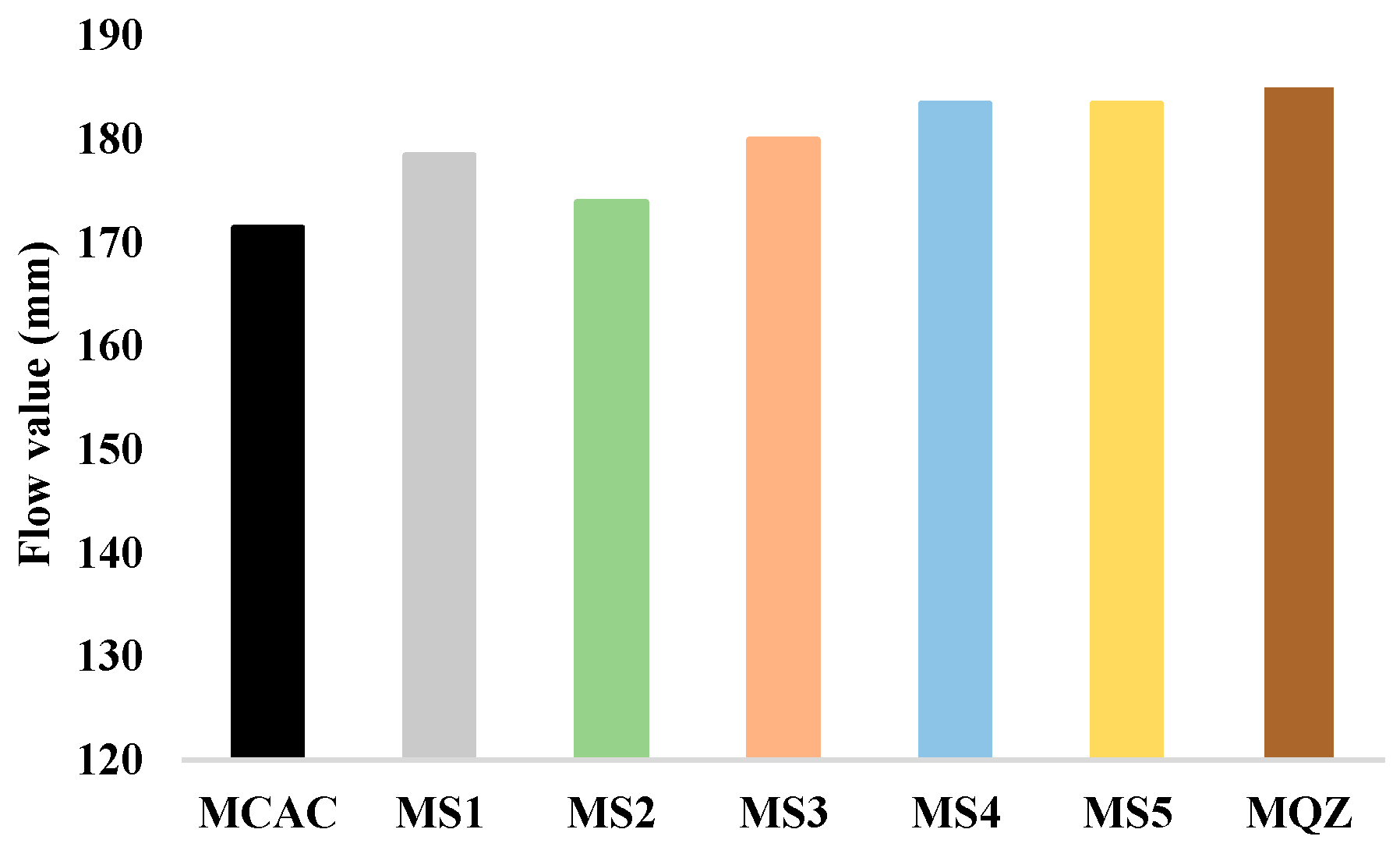
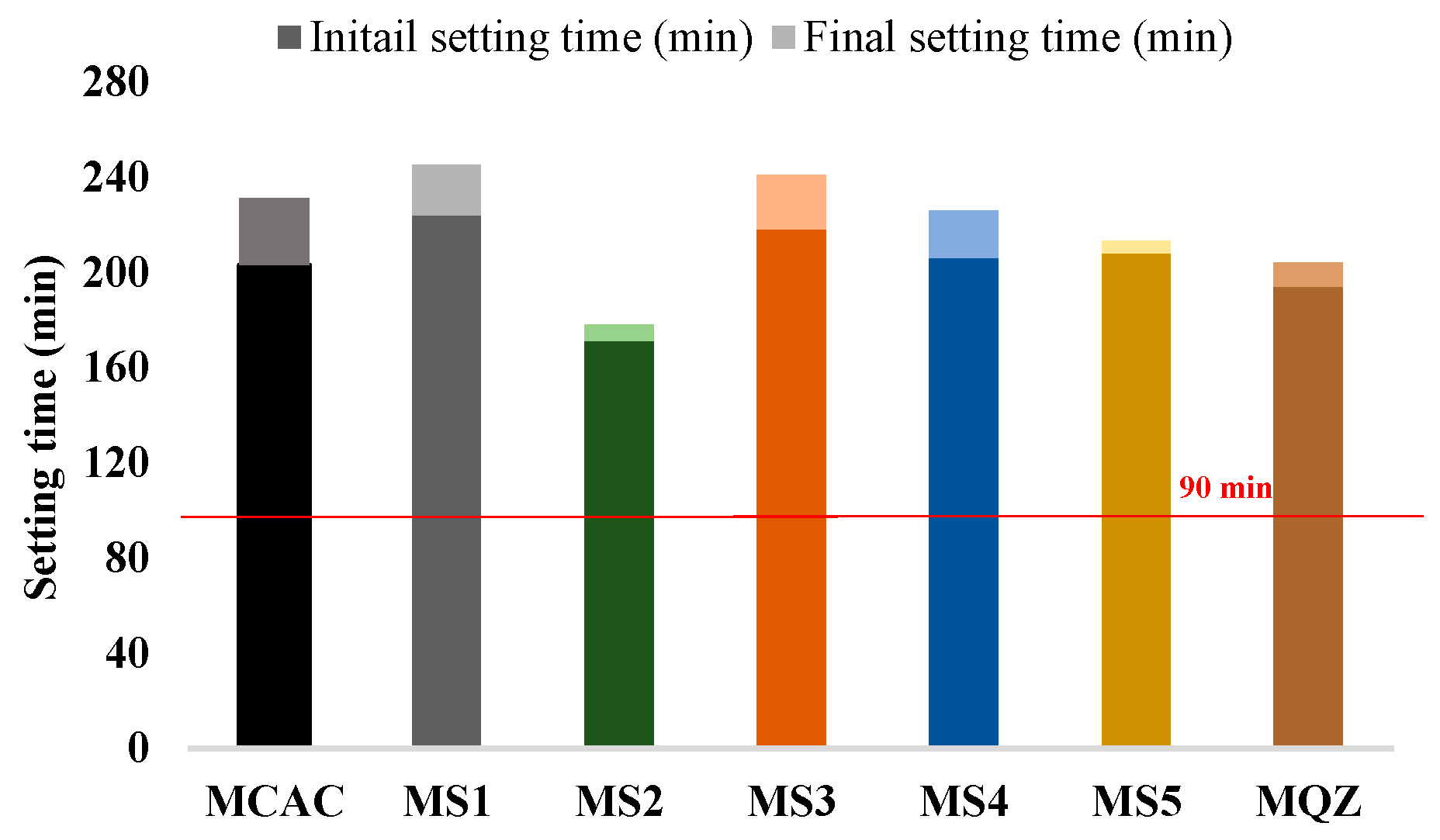
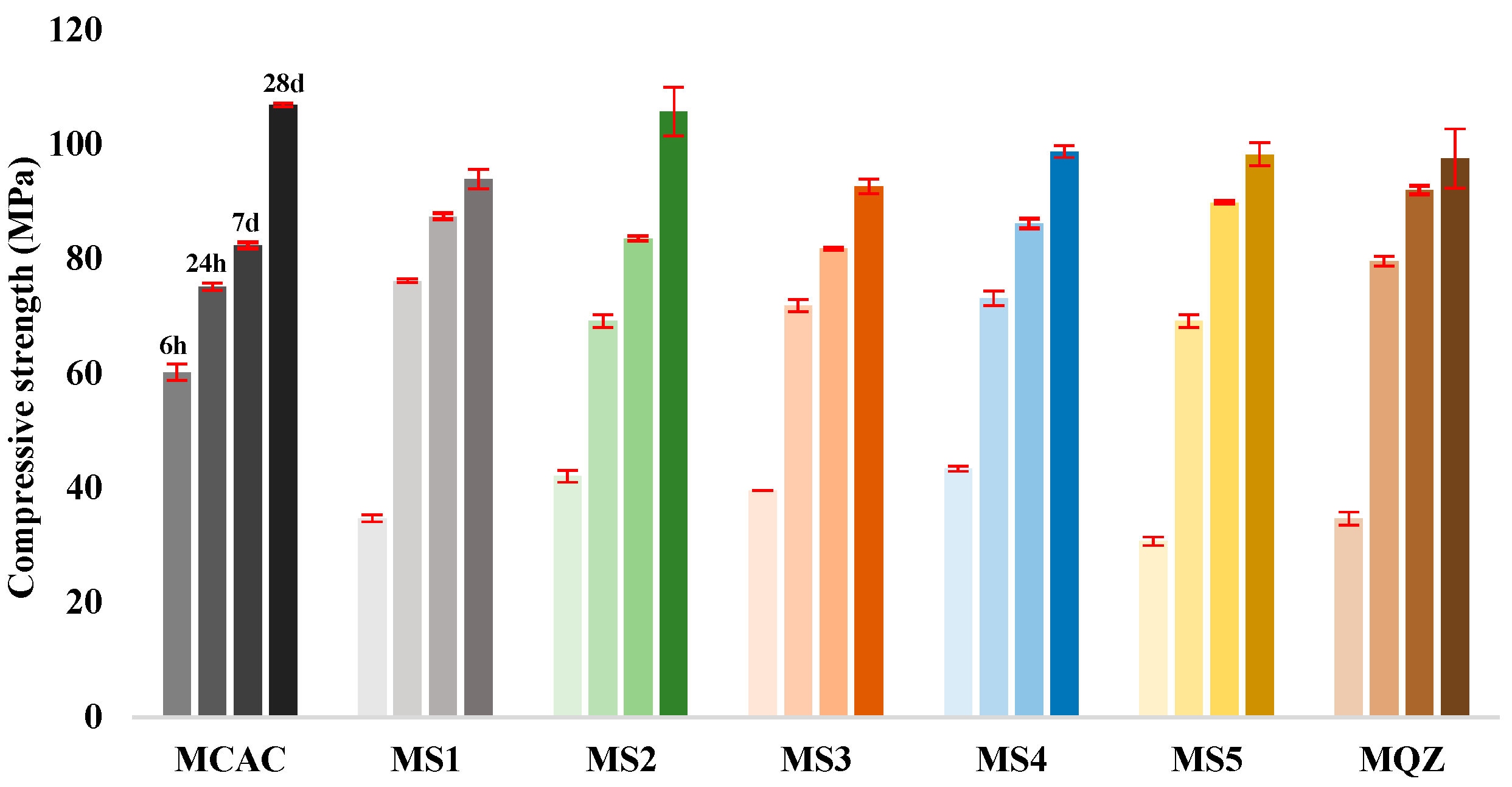


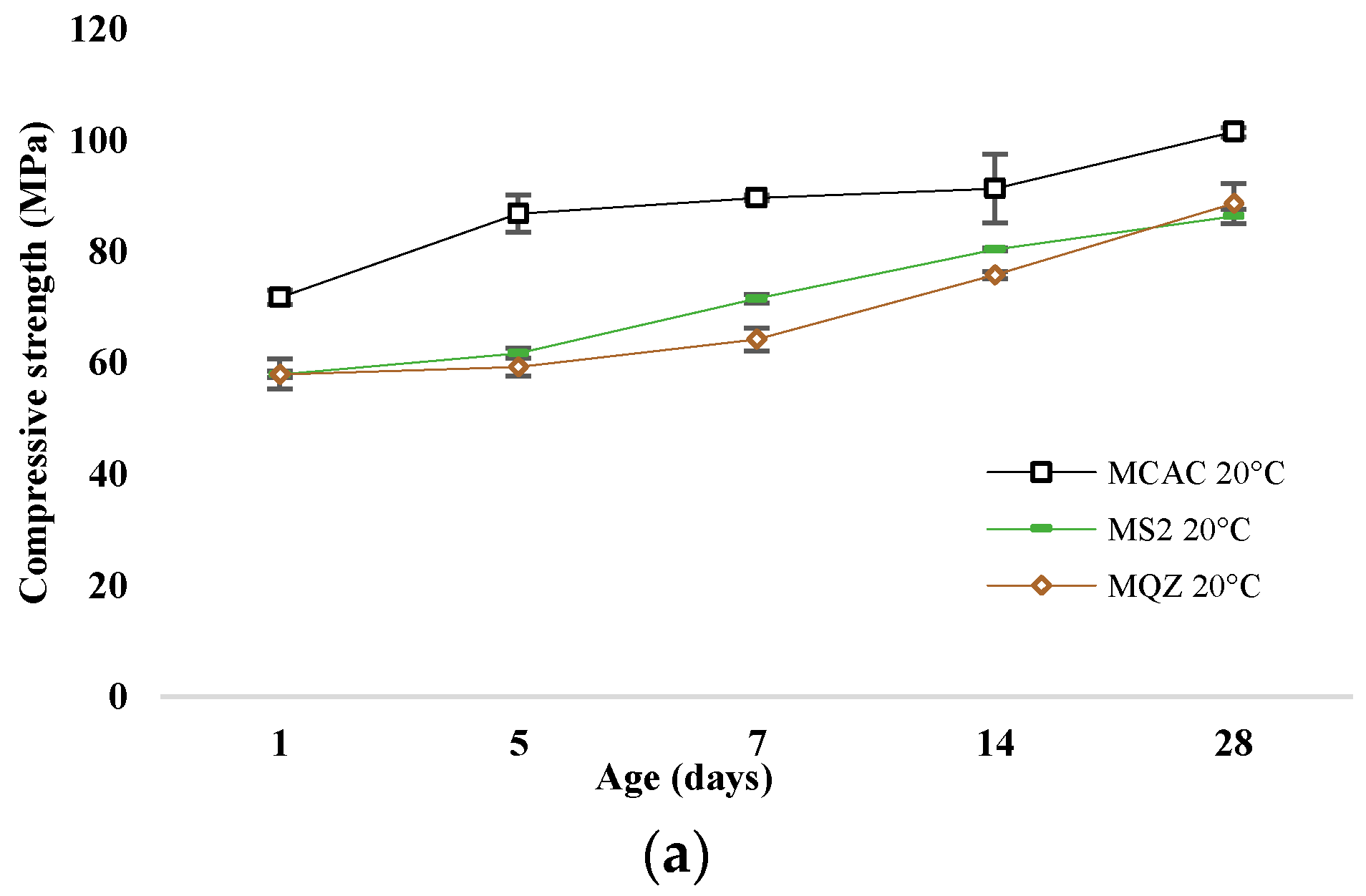

| Property | Unit | S1 | S2 | S3 | S4 | S5 |
|---|---|---|---|---|---|---|
| SiO2 | % | 38.2 | 35.4 | 39.8 | 36.6 | 35.6 |
| Al2O3 | % | 12.1 | 11.7 | 12 | 10.8 | 13.5 |
| TiO2 | % | 0.6 | 0.6 | 1.4 | 0.5 | 1.2 |
| MnO | % | 1.8 | 0.2 | 1.6 | 0.4 | 0.3 |
| Fe2O3 | % | 0.3 | 0.5 | 0.8 | 0.3 | 0.5 |
| CaO | % | 34.7 | 42.5 | 34.6 | 41.9 | 38.8 |
| MgO | % | 10.3 | 6.4 | 7.3 | 7.3 | 8.7 |
| K2O | % | 1.3 | 0.3 | 1 | 0.4 | 0.7 |
| Na2O | % | 0.4 | 0.3 | 0.2 | 0.2 | 0.4 |
| Na2O eq | % | 1.2 | 0.6 | 0.9 | 0.5 | 0.8 |
| SO3 | % | 0.3 | 1.2 | 0.4 | 1.4 | 0.6 |
| Chloride | % | nd | 0.14 | nd | nd | nd |
| Sulphide (S2−) | % | 0.12 | 0.48 | 0.16 | 0.56 | 0.24 |
| Moisture | % | 0 | 8.7 | 2.6 | 9.1 | 0.2 |
| d50 | μm | 53 | 41 | 26 | 36 | 31 |
| Fineness | cm2/g | 1768 | 2076 | 2668 | 2178 | 2407 |
| Density | g/cm3 | 2.94 | 2.86 | 2.93 | 2.85 | 2.94 |
| Compressive Strength, MPa | |||||
|---|---|---|---|---|---|
| 6 h | 24 h | 7 d | 28 d | ||
| Basicity according to Tetmajer (CaO/SiO2) | Pearson’s Corr. | 0.32 | −0.57 | 0.19 | 0.93 |
| p-value | 0.30 | 0.16 | 0.38 | 0.01 | |
| German Standard for “Eisenportlandzement” (CEM II-S) | Pearson’s Corr. | 0.31 | −0.34 | 0.30 | 0.85 |
| p-value | 0.30 | 0.28 | 0.62 | 0.03 | |
| German Standard for “Hochofenzement” I | Pearson’s Corr. | 0.20 | −0.41 | 0.72 | 0.86 |
| p-value | 0.37 | 0.25 | 0.27 | 0.03 | |
| German Standard for “Hochofenzement” II | Pearson’s Corr. | −0.18 | 0.74 | −0.24 | −0.84 |
| p-value | 0.39 | 0.08 | 0.35 | 0.04 | |
| German Standard for special cements | Pearson’s Corr. | −0.07 | −0.54 | 0.53 | 0.83 |
| p-value | 0.46 | 0.18 | 0.18 | 0.04 | |
| F-value according to Keil | Pearson’s Corr. | 0.04 | −0.63 | 0.40 | 0.88 |
| p-value | 0.48 | 0.13 | 0.25 | 0.03 | |
| Reactivity according to De Langavant | Pearson’s Corr. | 0.05 | −0.58 | 0.43 | 0.87 |
| p-value | 0.47 | 0.15 | 0.24 | 0.03 | |
| Basicity according to Schwiete | Pearson’s Corr. | 0.17 | −0.66 | 0.29 | 0.91 |
| p-value | 0.39 | 0.11 | 0.32 | 0.02 | |
| Reactivity according to Wang | Pearson’s Corr. | −0.01 | −0.47 | 0.51 | 0.84 |
| p-value | 0.49 | 0.21 | 0.19 | 0.04 | |
| European Standards for cement and blast-furnace slag I | Pearson’s Corr. | 0.11 | −0.46 | 0.43 | 0.86 |
| p-value | 0.43 | 0.22 | 0.23 | 0.03 | |
| European Standards for cement and blast-furnace slag II | Pearson’s Corr. | 0.52 | 0.01 | 0.20 | 0.60 |
| p-value | 0.19 | 0.50 | 0.37 | 0.14 | |
| F-value according to Ehrenberg | Pearson’s Corr. | 0.13 | −0.54 | 0.37 | 0.90 |
| p-value | 0.41 | 0.18 | 0.27 | 0.02 | |
| 6 h Heat, J/g SCM (R3 test) | Pearson’s Corr. | 0.75 | −0.24 | −0.39 | 0.84 |
| p-value | 0.07 | 0.35 | 0.26 | 0.04 | |
| 24 h Heat, J/g SCM (R3 test) | Pearson’s Corr. | 0.84 | −0.10 | −0.46 | 0.73 |
| p-value | 0.04 | 0.43 | 0.22 | 0.08 | |
| 3 d Heat, J/g SCM (R3 test) | Pearson’s Corr. | 0.84 | 0.07 | −0.47 | 0.62 |
| p-value | 0.04 | 0.46 | 0.21 | 0.13 | |
| 7 d Heat, J/g SCM (R3 test) | Pearson’s Corr. | 0.81 | 0.18 | −0.46 | 0.55 |
| p-value | 0.05 | 0.39 | 0.22 | 0.17 | |
| Bound water content, % (R3 test) | Pearson’s Corr. | 0.97 | 0.05 | −0.77 | 0.41 |
| p-value | 0.00 | 0.47 | 0.07 | 0.25 | |
| CaO/Al2O3 | Pearson’s Corr. | 0.81 | −0.15 | −0.22 | 0.68 |
| p-value | 0.05 | 0.40 | 0.36 | 0.10 | |
| CaO | Pearson’s Corr. | 0.48 | −0.53 | 0.06 | 0.90 |
| p-value | 0.21 | 0.18 | 0.46 | 0.02 | |
| Al2O3 | Pearson’s Corr. | −0.92 | −0.37 | 0.53 | −0.16 |
| p-value | 0.01 | 0.27 | 0.18 | 0.40 | |
| SiO2 | Pearson’s Corr. | 0.05 | 0.57 | −0.48 | −0.86 |
| p-value | 0.47 | 0.16 | 0.20 | 0.03 | |
| Moderate correlation | |||||
| High correlation | |||||
| Strong correlation | |||||
Disclaimer/Publisher’s Note: The statements, opinions and data contained in all publications are solely those of the individual author(s) and contributor(s) and not of MDPI and/or the editor(s). MDPI and/or the editor(s) disclaim responsibility for any injury to people or property resulting from any ideas, methods, instructions or products referred to in the content. |
© 2024 by the authors. Licensee MDPI, Basel, Switzerland. This article is an open access article distributed under the terms and conditions of the Creative Commons Attribution (CC BY) license (https://creativecommons.org/licenses/by/4.0/).
Share and Cite
Skočibušić Pejić, J.; Bašić, A.-D.; Grubor, M.; Serdar, M. Link between the Reactivity of Slag and the Strength Development of Calcium Aluminate Cement. Materials 2024, 17, 3551. https://doi.org/10.3390/ma17143551
Skočibušić Pejić J, Bašić A-D, Grubor M, Serdar M. Link between the Reactivity of Slag and the Strength Development of Calcium Aluminate Cement. Materials. 2024; 17(14):3551. https://doi.org/10.3390/ma17143551
Chicago/Turabian StyleSkočibušić Pejić, Josipa, Alma-Dina Bašić, Martina Grubor, and Marijana Serdar. 2024. "Link between the Reactivity of Slag and the Strength Development of Calcium Aluminate Cement" Materials 17, no. 14: 3551. https://doi.org/10.3390/ma17143551






